Aspar SDM-8I8O 8 Digital Inputs or Output Expansion Module User manual
- Type
- User manual

Home » aspar » aspar SDM-8I8O 8 Digital Inputs or Output Expansion Module User Manual
Contents
1 aspar SDM-8I8O 8 Digital Inputs or Output Expansion
Module
2 Safety rules
3 Module Features
4 Technical Specifications
5 Communication configuration
6 Switches
7 Front panel removing
8 Indicators
9 Module Connection
10 Modules Registers
11 Configuration software
12 Documents / Resources
12.1 References
13 Related Posts
aspar SDM-8I8O 8 Digital Inputs or Output Expansion Module
aspar SDM-8I8O 8 Digital Inputs or Output Expansion Module
User Manual
Manuals+ — User Manuals Simplified.

Thank you for choosing our product.
This manual will help you with proper support and proper operation of the device.
The information contained in this manual have been prepared with utmost care by our professionals and serve as
a description of the product without incurring any liability for the purposes of commercial law.
This information does not release you from the obligation of own judgement and verification.
We reserve the right to change product specifications without notice.
Please read the instructions carefully and follow the recommendations contained therein.
WARNING!
Failure to follow instructions can result in equipment damage or impede the use of the hardware or software.
Safety rules
Before first use, refer to this manual
Before first use, make sure that all cables are connected properly
Please ensure proper working conditions, according to the device specifications (eg: supply voltage,
temperature, maximum power consumption)
Before making any modifications to wiring connections, turn off the power supply
Module Features
Purpose and description of the module
The SDM-8I8O module is an innovative device that provides a simple and cost-effective extension of the
number of lines of input and output in popular PLCs.

The module has 8 digital inputs with configurable timer/counter option and 8 digital outputs. In addition,
terminals IN1 and IN2 and IN3 and IN4 can be used to connect two encoders. All inputs and outputs are
isolated from the logic of using optocouplers. Each channel can be individually configured in one of several
modes.
This module is connected to the RS485 bus with twisted-pair wire. Communication is via MODBUS RTU or
MODBUS ASCII. The use of 32-bit ARM core processor provides fast processing and quick communication.
The baud rate is configurable from 2400 to 115200.
The module is designed for mounting on a DIN rail in accordance with DIN EN 5002.
The module is equipped with a set of LEDs used to indicate the status of inputs and outputs useful for
diagnostic purposes and helping to find errors.
Module configuration is done via USB by using a dedicated computer program. You can also change the
parameters using the MODBUS protocol.
Technical Specifications

Power Supply
Voltage 10-30 VDC; 10-28VAC
Maximum Current*DC: 100 mA @ 24VDC AC: 125 mA @ 24VAC
Maximum power consumption DC: 2.4W; AC: 3VA
Digital Inputs
No of inputs 8
Voltage range 0 – 36V
Low State „0” 0 – 3V
High State „1” 6 – 36V
Input impedance 4kΩ
Isolation 1500 Vrms
Input Type PNP lub NPN
Digital Outputs
No of outputs 8
Max Voltage 30V
Max current 500mA
Output Type PNP
Output protection 4A polymer fuse
Isolation 1500 Vrms
Counters
No 8
Resolution 32 bity
Frequency 1kHz (max)
Impulse Width 500 μs (min)
Temperature
Work -10 °C – +50°C
Storage -40 °C – +85°C
Connectors
Power Supply 2 pins
Communication 3 pins
Inputs 10 pins
Outputs 10 pins
Configuration Mini USB
Size
Height 110 mm
Length 62 mm
Width 88 mm
Interface RS485 Do 128 urządzeń
Maximum current with active Modbus transmission, all outputs on and high state on all inputs

Dimensions of the product
Look and dimensions of the module are shown below. The module is mounted directly to the rail in the DIN
industry standard. Power connectors, communication and IOs are at the bottom and top of the module. USB
connector configuration and indicators located on the front of the module.
Communication configuration
Grounding and shielding
In most cases, IO modules will be installed in an enclosure along with other devices which generate
electromagnetic radiation. Examples of these devices are relays and contactors, transformers, motor controllers
etc. This electromagnetic radiation can induce electrical noise into both power and signal lines, as well as direct
radiation into the module causing negative effects on the system. Appropriate grounding, shielding and other
protective steps should be taken at the installation stage to prevent these effects. These protective steps include
control cabinet grounding, module grounding, cable shield grounding, protective elements for electromagnetic
switching devices, correct wiring as well as consideration of cable types and their cross sections.
Network Termination
Transmission line effects often present a problem on data communication networks. These problems include
reflections and signal attenuation.
To eliminate the presence of reflections from the end of the cable, the cable must be terminated at both ends with
a resistor across the line equal to its characteristic impedance. Both ends must be terminated since the direction
of propagation is bi-directional. In the case of an RS485 twisted pair cable this termination is typically 120 Ω.
Setting Module Address in RS485 Modbus Network
The following table shows how to set switch to determine the address of the module. The module address is set
with the switches in the range of 0 to 127. Addresses From 128 to 255 can by set via RS485 or USB.

Switch Adress
SW1 +1
SW2 +2
SW3 +4
SW4 +8
SW5 +16
SW6 +32
SW7 +64
Ex. if switches 1, 3 and 5 are on than module addres is:
Address = 1 + 4 + 16 = 21
Types of Modbus Registers
There are 4 types of variables available in the module.
Type Beginning adress Variable Access Modbus Command
1 00001 Digital Outputs
Bit
Read & Write 1, 5, 15
2 10001 Digital Inputs Bit Read 2
3 30001 Input Registers Registered Read 3
4 40001 Output Registers Registered Read &
Write 4, 6, 16
Communication settings
The data stored in the modules memory are in 16-bit registers. Access to registers is via MODBUS RTU or
MODBUS ASCII.
Default settings
You can restore the default configuration by the switch SW8 (see 3.5.2 – Restore the default configuration)
Boud rate 19200
Pariti Nie
Data bits 8
Stop bits 1
Reply Delay [ms] 0
Modbus Type RTU

Restore the default configuration
To restore the default configuration:
turn off the power
turn on the switch SW8
turn on the power
when power and communication LED start blinking alternately than turn off the switch SW8
Caution! After restoring the default configuration all values stored in the registers will be cleared as well.
Configuration registers
Modbus Dec Hex Name Values
40003
2
0x02
Baud rate
0 – 2400
1 – 4800
2 – 9600
3 – 19200
4 – 38400
5 – 57600
6 – 115200
other – value * 10
40005
4
0x04
Parity
0 – none
1 – odd
2 – even
3 – always 1
4 – always 0
40004 3 0x03 Stop Bits LSB 1 – one stop bit 2 – two stop bit
40004 3 0x03 Data Bits MSB
7 – 7 data bits
8 – 8 data bits
40006 5 0x05 Response delay Time in ms
40007 6 0x06 Modbus Mode
0 – RTU
1 – ASCII
Watchdog function

This 16-bit register specifies the time in milliseconds to watchdog reset. If module does not receive any valid
message within that time, all Digital and Analog Outputs will be set to the default state.
This feature is useful if there is an interruption in data transmission and for security reasons. Output states must
be set to the appropriate state in order to assure the safety of persons or property.
The default value is 0 milliseconds which means the watchdog function is disabled.
Range: 0-65535 ms
Switches
Switch Function Description
1 Module address +1
Setting module address from 0 to 127
2 Module address +2
3 Module address +4
4 Module address +8
5 Module address +16
6Module address +32
7 Module address +64
8Restoring default settings
Restoring default settings
(see 3.5.1 – Default settings i 3.5.2 – Restore the default
configuration).
Front panel removing
To remove the panel and gain access to the switch, you must pry open the panel using a thin tool (eg a small
screwdriver) as in the picture below.

Indicators
Indicators Description
Power supply LED indicates that the module is correctly powered.
Communication The LED lights up when the unit received the correct packet and sends the answer.
Inputs state LED indicates that the signal to input is connected.
Outputs state LED indicates that the output is on.
Module Connection
Digital inputs

Digital outputs
Communication, power supply
Modules Registers
Registered access
Modbu
sDec Hex Register Name Access Description
30001 0 0x00 Version/Type Read Version and Type of the device
30002 1 0x01 Switches Read Switches state
40003 2 0x02 Baud rate Read & Write RS485 baud rate
40004 3 0x03 Stop Bits & Data Bits Read & Write No of Stop bits & Data Bits
40005 4 0x04 Parity Read & Write Parity bit

40006 5 0x05 Response Delay Read & Write Response delay in ms
40007 6 0x06 Modbus Mode Read & Write Modbus Mode (ASCII or RTU)
40009 8 0x08 Watchdog Read & Write Watchdog
40013 12 0x0C Default Output State Read & Write Default output state (after power on or wat
chdog reset)
40033 32 0x20 Received packets LSB Read & Write
No of received packets
40034 33 0x21 Received packets MSB Read & Write
40035 34 0x22 Incorrect packets LSB Read & Write
No of received packets with error
40036 35 0x23 Incorrect packets MSB Read & Write
40037 36 0x24 Sent packets LSB Read & Write
No of sent packets
40038 37 0x25 Sent packets MSB Read & Write
30051 50 0x32 Inputs Read Inputs state
40052 51 0x33 Outputs Read & Write Output state
40053 52 0x34 Counter 1 LSB Read & Write
32-bit counter 1
40054 53 0x35 Counter 1 MSB Read & Write
40055 54 0x36 Counter 2 LSB Read & Write
32-bit counter 2
40056 55 0x37 Counter 2 MSB Read & Write
40057 56 0x38 Counter 3 LSB Read & Write
32-bit counter 3
40058 57 0x39 Counter 3 MSB Read & Write
40059 58 0x3A Counter 4 LSB Read & Write
32-bit counter 4
40060 59 0x3B Counter 4 MSB Read & Write
40061 60 0x3C Counter 5 LSB Read & Write
32-bit counter 5
40062 61 0x3D Counter 5 MSB Read & Write
40063 62 0x3E Counter 6 LSB Read & Write
32-bit counter 6
40064 63 0x3F Counter 6 MSB Read & Write
40065 64 0x40 Counter 7 LSB Read & Write
32-bit counter 7
40066 65 0x41 Counter 7 MSB Read & Write
40067 66 0x42 Counter 8 LSB Read & Write
32-bit counter 8
40068 67 0x43 Counter 8 MSB Read & Write

Modbu
sDec Hex Register Name Access Description
40085 84 0x54 CCounter 1 LSB Read & Write
32-bit value of captured counter 1
40086 85 0x55 CCounter 1 MSB Read & Write
40087 86 0x56 CCounter 2 LSB Read & Write
32-bit value of captured counter 2
40088 87 0x57 CCounter 2 MSB Read & Write
40089 88 0x58 CCounter 3 LSB Read & Write
32-bit value of captured counter 3
40090 89 0x59 CCounter 3 MSB Read & Write
40091 90 0x5A CCounter 4 LSB Read & Write
32-bit value of captured counter 4
40092 91 0x5B CCounter 4 MSB Read & Write
40093 92 0x5C CCounter 5 LSB Read & Write
32-bit value of captured counter 5
40094 93 0x5D CCounter 5 MSB Read & Write
40095 94 0x5E CCounter 6 LSB Read & Write
32-bit value of captured counter 6
40096 95 0x5F CCounter 6 MSB Read & Write
40097 96 0x60 CCounter 7 LSB Read & Write
32-bit value of captured counter 7
40098 97 0x61 CCounter 7 MSB Read & Write
40099 98 0x62 CCounter 8 LSB Read & Write
32-bit value of captured counter 8
40100 99 0x63 CCounter 8 MSB Read & Write
40117 116 0x74 Counter Config 1 Read & Write
Counter Configuration
+1 – time measurement (if 0 counting
impulses)
+2 – autocatch counter every 1 sec
+4 – catch value when input low
+8 – reset counter after catch
+16 – reset counter if input low
+32 – encoder (only for counter 1 and 3)
40118 117 0x75 Counter Config 2 Read & Write
40119 118 0x76 Counter Config 3 Read & Write
40120 119 0x77 Counter Config 4 Read & Write
40121 120 0x78 Counter Config 5 Read & Write
40122 121 0x79 Counter Config 6 Read & Write
40123 122 0x7A Counter Config 7 Read & Write
40124 123 0x7B Counter Config 8 Read & Write
40133 132 0x84 Catch Read & Write Catch counter
40134 133 0x85 Status Read & Write Captured counter

Bit access
Modbus A
ddress
Dec Add
ress
Hex Add
ress Register name Access Description
193 192 0x0C0 Default state of output 1 Read & Write Default state of output 1
194 193 0x0C1 Default state of output 2 Read & Write Default state of output 2
195 194 0x0C2 Default state of output 3 Read & Write Default state of output 3
196 195 0x0C3 Default state of output 4 Read & Write Default state of output 4
197 196 0x0C4 Default state of output 5 Read & Write Default state of output 5
198 197 0x0C5 Default state of output 6 Read & Write Default state of output 6
199 198 0x0C6 Default state of output 7 Read & Write Default state of output 7
200 199 0x0C7 Default state of output 8 Read & Write Default state of output 8
10801 800 0x320 Input 1 Read Input 1 state
10802 801 0x321 Input 2 Read Input 2 state
10803 802 0x322 Input 3 Read Input 3 state
10804 803 0x323 Input 4 Read Input 4 state
10805 804 0x324 Input 5 Read Input 5 state
10806 805 0x325 Input 6 Read Input 6 state
10807 806 0x326 Input 7 Read Input 7 state
10808 807 0x327 Input 8 Read Input 8 state
817 816 0x330 Output 1 Read & Write Output 1 state
818 817 0x331 Output 2 Read & Write Output 2 state
819 818 0x332 Output 3 Read & Write Output 3 state
820 819 0x333 Output 4 Read & Write Output 4 state
821 820 0x334 Output 5 Read & Write Output 5 state
822 821 0x335 Output 6 Read & Write Output 6 state
823 822 0x336 Output 7 Read & Write Output 7 state
824 823 0x337 Output 8 Read & Write Output 8 state
2113 2112 0x840 Capture 1 Read & Write Capture counter 1
2114 2113 0x841 Capture 2 Read & Write Capture counter 2
2115 2114 0x842 Capture 3 Read & Write Capture counter 3
2116 2115 0x843 Capture 4 Read & Write Capture counter 4
2117 2116 0x844 Capture 5 Read & Write Capture counter 5
2118 2117 0x845 Capture 6 Read & Write Capture counter 6

2119 2118 0x846 Capture 7 Read & Write Capture counter 7
2120 2119 0x847 Capture 8 Read & Write Capture counter 8
Modbus A
ddress
Dec Add
ress
Hex Add
ress Register name Access Description
2129 2120 0x848 Captured 1 Read & Write Captured value of counter 1
2130 2129 0x849 Captured 2 Read & Write Captured value of counter 2
2131 2130 0x84A Captured 3 Read & Write Captured value of counter 3
2132 2131 0x84B Captured 4 Read & Write Captured value of counter 4
2133 2132 0x84C Captured 5 Read & Write Captured value of counter 5
2134 2133 0x84D Captured 6 Read & Write Captured value of counter 6
2135 2134 0x84E Captured 7 Read & Write Captured value of counter 7
2136 2135 0x84F Captured 8 Read & Write Captured value of counter 8
Configuration software
Modbus Configurator is software that is designed to set the module registers responsible for communication over
Modbus network as well as to read and write the current value of other registers of the module. This program can
be a convenient way to test the system as well as to observe real-time changes in the registers.
Communication with the module is done via the USB cable. The module does not require any drivers.
Configurator is a universal program, whereby it is possible to configure all available modules.

Manufactured for: Aspar s.c.
ul. Oliwska 112
80-209 Chwaszczyno
POLAND
ampero@ampero.eu
www.ampero.eu
Tel. +48 58 351 39 89; +48 58 732 71 73
Documents / Resources
aspar SDM-8I8O 8 Digital Inputs or Output Expansion Module [pdf] User Manual
SDM-8I8O, 8 Digital Inputs or Output Expansion Module, SDM-8I8O 8 Digital Inputs or Output
Expansion Module, Digital Inputs or Output Expansion Module, Inputs or Output Expansion Mo
dule, Expansion Module, Module
References
ASPAR s.c.
Manuals+,
-
 1
1
-
 2
2
-
 3
3
-
 4
4
-
 5
5
-
 6
6
-
 7
7
-
 8
8
-
 9
9
-
 10
10
-
 11
11
-
 12
12
-
 13
13
-
 14
14
-
 15
15
Aspar SDM-8I8O 8 Digital Inputs or Output Expansion Module User manual
- Type
- User manual
Ask a question and I''ll find the answer in the document
Finding information in a document is now easier with AI
Related papers
-
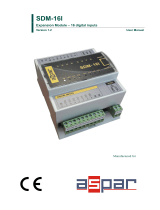 Aspar SDM-16I 16 Digital Inputs Expansion Module User manual
Aspar SDM-16I 16 Digital Inputs Expansion Module User manual
-
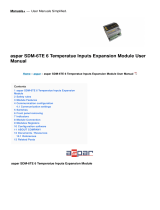 Aspar SDM-6TE 6 Temperatue Inputs Expansion Module User manual
Aspar SDM-6TE 6 Temperatue Inputs Expansion Module User manual
-
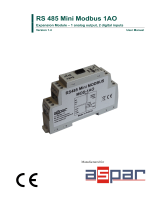 Aspar MOD-1AO 1 Analog Universal Output User manual
Aspar MOD-1AO 1 Analog Universal Output User manual
-
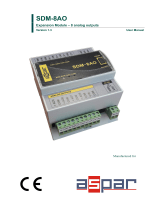 Aspar SDM-8AO 8 Analog Outputs Expansion Module User manual
Aspar SDM-8AO 8 Analog Outputs Expansion Module User manual
-
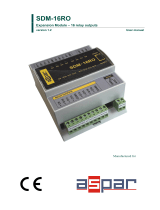 Aspar SDM-16RO Expansion Module User manual
Aspar SDM-16RO Expansion Module User manual
-
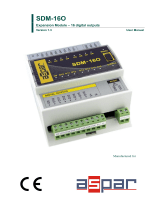 Aspar SDM-16O 16 Digital Outputs Expansion Module User manual
Aspar SDM-16O 16 Digital Outputs Expansion Module User manual
-
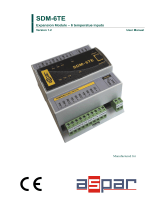 Aspar SDM-6TE 6 Temperatue Inputs Expansion Module User manual
Aspar SDM-6TE 6 Temperatue Inputs Expansion Module User manual
Other documents
-
 iSMACONTROLLI SfAR-1M-2DI2DO Expansion Module 2 Digital Inputs 2 Digital Outputs User manual
iSMACONTROLLI SfAR-1M-2DI2DO Expansion Module 2 Digital Inputs 2 Digital Outputs User manual
-
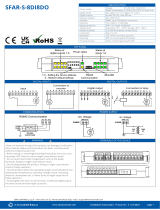 iSMA CONTROLLI SFAR-S-8DI8DO Installation guide
iSMA CONTROLLI SFAR-S-8DI8DO Installation guide
-
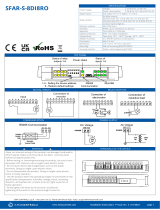 iSMA CONTROLLI SFAR-S-8DI8RO Installation guide
iSMA CONTROLLI SFAR-S-8DI8RO Installation guide
-
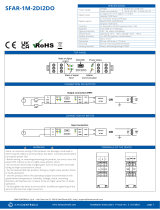 iSMA CONTROLLI SFAR-1M-2DI2DO Installation guide
iSMA CONTROLLI SFAR-1M-2DI2DO Installation guide
-
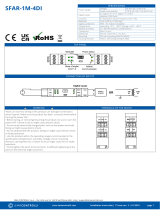 iSMA CONTROLLI SFAR-1M-4DI Installation guide
iSMA CONTROLLI SFAR-1M-4DI Installation guide
-
iSMA CONTROLLI SFAR-1M-4DI-M Installation guide
-
iSMACONTROLLI SFAR-S-16DI-M User manual
-
WEG SSW900 User manual
-
WEG SSW900 User manual
-
INVT IVC1S Programming Manual


























